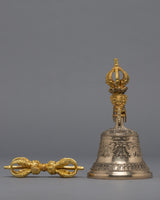
Buddhist Vajra and Bell | Tibetan Symbolism

100% AUTHENTIC

HANDMADE

FREE SHIPPING
Buddhist Vajra and Bell
About Vajra & Bell
The Buddhist Vajra and Bell is a beautifully crafted brass piece with intricate designs and symbols that hold deep spiritual significance. The handle of the Vajra is plated with gold, adding a touch of luxury and richness to the piece. The Bell is also made of brass and has a beautifully shaped body and a flared opening, creating a resonant sound when struck.
Introduction to Vajra & Bell
The vajra means "diamond" or "lightning" in Sanskrit, is an important symbol and ritual instrument in Hinduism and more in the Buddhist tradition Vajrayana ("diamond way") to which it gave its name.
Tibetan Dorje represents the indestructibility and efficiency that overcomes all obstacles. Symbolically, Dorje Vajra destroys ignorance. In Tibetan Buddhist rituals, the vajra is often used with the bell, representing the masculine and the feminine, the ying and the yang, the effective action, and the compassion. The shape of the Tibetan Dorje is symmetrical, the two pyramidal heads representing samsara and Nirvana, which cancel each other out in its center thanks to the ring of Emptiness. Having a Dorje at home would have positive virtues against the various attacks we suffer.
The bell or drills is the feminine aspect of the perfection of wisdom, which directly realizes emptiness.
The Vajra or Dorje represents the male aspect as a method or skillful means, the indestructible nature of the absolute. Together they symbolize the blessing mandala of a practitioner’s main yidam deity.
-----------------------------------------------------------------------
Vajra Size: 3 cm(Height) and 12 cm(Base)
Bell Size: 18 cm(Height) and 10 cm(Base)
Total Weight:0.590 kg
-----------------------------------------------------------------------
How to set up your own Buddhist Shrine?
-Find a clean, quiet, and uncluttered spot.
-Set up an altar table, and cover it with an altar cloth that calls to you.
-Place your sacred item (statue, thangka, or a picture of Buddha) at the center.
Shipping & Returns
We ship worldwide. Orders dispatch in 2–3 business days. International delivery typically arrives in 4–10 business days via DHL Express, depending on destination and carrier conditions. All items ship free globally.
Returns are accepted within 14 days of delivery. Products must be returned in original condition for a refund to be issued once received and inspected. Terms and conditions apply.











